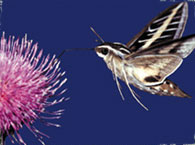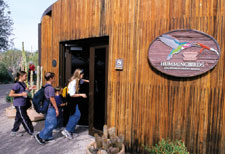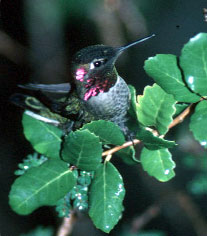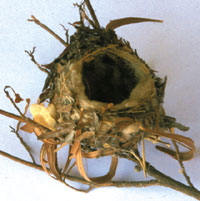Pollination Gardens

White-lined sphinx moth
an important pollinator in the Sonoran Desert

Hummingbird Aviary entrance
photo by Paul S. Berquist

Anna's Hummingbird in ASDM aviary
photo by James Flynn

Hummingbird Nest with spider webs
Birds, bees and butterflies are the stars of these gardens. The Hummingbird Aviary is a scene of constant action as the tiny, iridescent "jewels of the desert" dart and hover so closely you can feel the air disturbed by their wings! In breeding season, nets are near enough to sneak a peek at the babies! Bring your cameras as the birds seem to pose for photos! The aviary is a marked contrast to the lovely Pollination Garden outside, where butterflies and bees float and drone peacefully between blossoms.
Hummingbird Aviary Background
by Karen Krebbs
When we first opened the Arizona-Sonora Desert Museum's hummingbird aviary, we had no idea whether or not any of the seven species of the birds on exhibit would breed and rear young. Since opening day, however, we've seen Costas, Broad-billed, Black-chinned, Anna's, and Calliope hummingbirds nest, lay eggs, and rear young. There have been a total of 114 nests built, 186 eggs laid, 116 birds hatched, and 102 birds fledged. No other zoological institution can boast of such success!
But this success has not come without a good deal of effort on the part of the exhibit keepers and the hummingbirds - especially when it comes to nest-building. For example, in 1992 we renovated the exhibit, clearing out all the plants and expanding and replanting the new space. Within a month of the renovation, several hummingbirds began to build nests.
The nests were loose and quite fragile, and even experienced nesters were having difficulty. Most of the nests fell apart and we lost several eggs that fell out and broke. We scratched our heads for days trying to figure out the problem before we finally concluded that a primary component of hummingbird nests was missing spider webs!
Hummingbirds use spider webbing as a way to bind and tie their nests together. The spiders had yet to reestablish themselves in the spanking new exhibit. I immediately went out and collected webs from around the grounds, rolling them up on twigs, which I left in the aviary. I also collected 25 labyrinth spiders and introduced them. Within days the spiders were weaving their webs in the aviary and the birds' nests immediately improved.